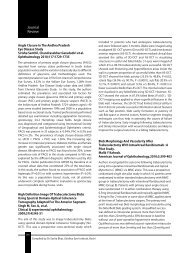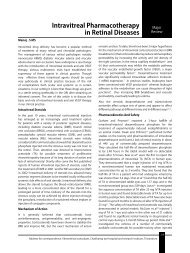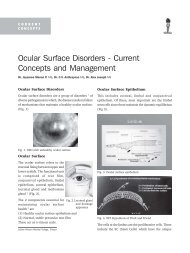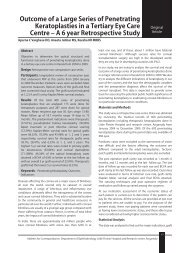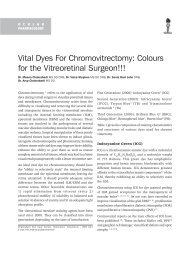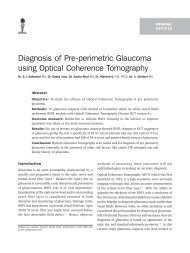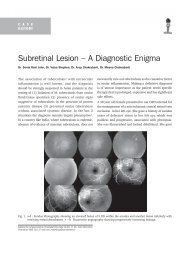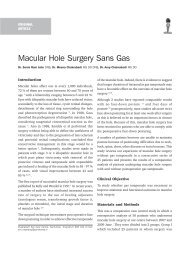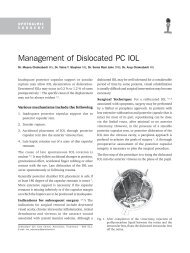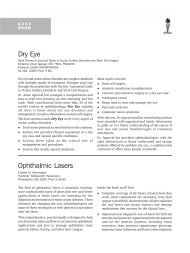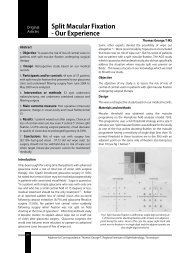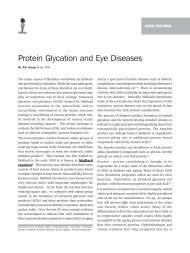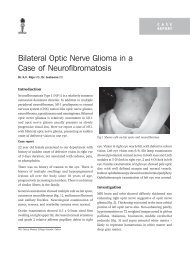Artificial Human vision - KSOS
Artificial Human vision - KSOS
Artificial Human vision - KSOS
You also want an ePaper? Increase the reach of your titles
YUMPU automatically turns print PDFs into web optimized ePapers that Google loves.
422 Kerala Journal of Ophthalmology Vol. XXI, No. 4<br />
segmentation) or a scene understanding approach,<br />
attempting to extract information that can be used.<br />
• Transmitter is the link from the camera/ image<br />
processing components to the stimulator and<br />
electrode array,( which are usually located inside<br />
the body). Percutaneous or transcutaneous<br />
connections can be used for this connection 6 . A<br />
transcutaneous connection uses radiofrequency<br />
telemetry to send data and power to the embedded<br />
stimulator where as percutaneous devices uses<br />
direct cables. The transcutaneous devices have the<br />
advantages of reduced risk of infection.<br />
Even though earlier devices were made for<br />
Percutaneous connections the new generation ones<br />
are transcutaneous. This is being used in the current<br />
trials of new generation intelligent medical implant<br />
systems and by other researchers.<br />
• Electrodes are thin wires, which allow a small<br />
amount of precisely controlled electrical current to<br />
pass through it to stimulate the neurons. There are<br />
two main types of electrodes discussed in the<br />
literature; surface electrodes, which lie flat against<br />
the stimulation target and penetrating electrodes,<br />
which are inserted inside the stimulation target.<br />
Stimulator, located outside the body receives<br />
information from the transmitter and send through<br />
multiple electrodes.<br />
Subretinal Prosthesis are different from all other forms<br />
of artificial <strong>vision</strong> devices in terms of location of<br />
implantation, its energy needs, proximity to the inner<br />
retinal layers, existence in the subretinal atmosphere,<br />
heat generation etc. the details of this will be described<br />
later in this article.<br />
Types of artificial <strong>vision</strong> devices<br />
Different methods of implants are tried in different parts<br />
of the visual pathway starting from retina, optic nerve<br />
and optic radiation.<br />
(a) Cortical prosthesis; (photograph)<br />
In 1929, Forester noticed that cortical stimulation with<br />
electrodes caused the subject to see a spot of light in a<br />
position that depended on the site of stimulation 7 . Later<br />
in sixties and early seventies Brindley and Lewin worked<br />
on this and implanted an array of 80 platinum<br />
electrodes in a 52-year-old legally blind. Stimulation<br />
of these electrodes produced discernible phosphenes<br />
and also found that phosphenes moved with eye<br />
movements and that phosphene perception usually (but<br />
not always) stopped when stimulation ceased 8 .<br />
Dobelle worked on this and came out with similar<br />
reports of stimulus perception. In late seventies he used<br />
a 64-channel platinum electrode surface stimulation<br />
prosthesis and showed that it can allow blind patients<br />
to recognize 6-inch characters at 5 feet (approximately<br />
20/1200 visual acuity) 7 . Patients in these initial<br />
experiments complained of an inability to appreciate<br />
distinct phosphenes, but rather reported seeing “halos”<br />
surrounding each of these phosphenes 9 . This approach<br />
has advantage of the potential to restore <strong>vision</strong> to the<br />
largest number of blind patients as it bypasses all<br />
diseased visual pathway neurons rostral to the primary<br />
visual cortex.But the disadvantages includes the<br />
difficulties encountered in controlling the number of<br />
phosphenes induced by each electrode, and interactions<br />
between phosphenes, need for high currents and large<br />
electrodes that can induce pain due to meningeal<br />
stimulation and occasional focal epileptic activity<br />
following electrical stimulation.<br />
There are two methods for cortical stimulation<br />
discussed. The one with surface stimulation electrodes<br />
and other with intra cortical electrodes. Intra cortical<br />
stimulation was introduced in the hope of remedying<br />
the shortcomings of surface cortical stimulation via a<br />
lower current and higher fidelity system. This employed<br />
smaller electrodes closer to the target neurons,<br />
therefore requiring less current and resulting in a more<br />
localized stimulation. Initial studies, during which the<br />
intra cortical prosthesis was implanted in humans for<br />
a trial period of 4 months, demonstrated the ability to<br />
produce phosphenes which exhibited colour. Current<br />
models of the intra cortical prosthesis which are being<br />
studied in animal models include the Illinois Intra<br />
cortical Visual Prosthesis project and the Utah Electrode<br />
Array 10 .<br />
In 2000 Dobelle reported a case report of a patient who<br />
has stayed implanted with his cortical prosthesis for<br />
20 years 9 . This cortical implant system from the Dobelle<br />
institute was made commercially available (not<br />
approved by the FDA) and there was an article in the<br />
Wall Street Journal, which reported a 33-year-old



